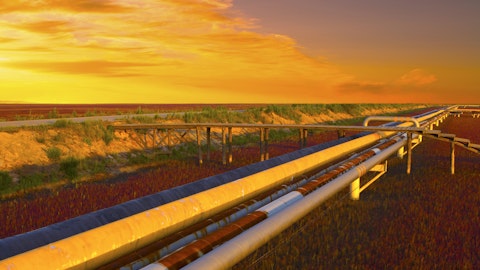Stabilis Solutions, Inc. (NASDAQ:SLNG) Q4 2022 Earnings Call Transcript March 9, 2023
Operator: Good morning, ladies and gentlemen, and welcome to the Stabilis Solutions Fourth Quarter and Full Year 2022 Earnings Conference Call. Joining us today are Westy Ballard, President and CEO; and Andy Puhala, Chief Financial Officer. Before we begin, I would like to remind everyone that today’s conference call will contain forward-looking statements within the meaning of the Private Securities Reform Act of 1985 and other securities laws. These forward-looking statements are based on the Company’s beliefs and expectations as of today, March 9, 2023. Forward-looking statements are subject to the risks and uncertainties that may cause actual results to differ materially from those projected. The Company undertakes no obligation to release updates or revisions to the forward-looking statements made in today’s conference call.
Additional information concerning factors that could cause those differences is contained in the Company’s filings with the SEC and the press release announcing the Company’s results. Investors are cautioned not to place undue reliance on any forward-looking statements. Please also note that the Company may refer to certain non-GAAP financial information on today’s call. You can find reconciliations of the non-GAAP financial measures to the most comparable GAAP measures in the Company’s earnings press release. Today’s call is being recorded. Currently, I’d like to turn the call over to Westy Ballard, President and CEO of Stabilis Solutions. Please go ahead.
Westy Ballard: Thank you, and good morning, and welcome to all of you that joined our call. Let me start by congratulating our entire company for delivering a fantastic 2022 despite considerable geopolitical and financial instability around the world. We remain focused and deliberate and executed on two key areas that we outlined for you this time last year. One, the optimization and enhancement of our existing business and operating model; and two, the advancement of our strategy into new and really exciting markets. Along the operational front, our team did a tremendous job managing costs with power, natural gas feedstock and transportation as the main culprits. Behind the scenes, we also consolidated offices, divested non-core assets in Brazil and Mexico, closely monitored overtime and job site labor costs and streamline our commercial organization.
Also during the year, our commercial and operational teams developed and executed on strategies to rationalize our customer base, elevate pricing, enhance profitability and improve return on assets. We began laying the foundation for growth into the large and rapidly growing industries of marine and aerospace. We successfully executed bunkering operations on three costs throughout the year and provided rocket fuel on two. Revenue across both sectors increased year-over-year to 24% of total revenue versus roughly 5% in 2021, which is noteworthy as we are expanding our revenue base into markets that are roughly 20 times to 30 times larger than our historical industrial business. In addition to bunkering operations, we developed an international export capability, and in September, announced that the U.S. Department of Energy granted us a 28-year license to export domestically produced LNG equivalent to roughly 52 billion cubic feet of natural gas annually.
The DOE’s approval not only provides us with the ability to assist in the world’s lingering energy crisis, but is yet another wonderful opportunity for us to play a larger role in the world’s addition of cleaner energy sources over the long term. This capability is very exciting and appears the market agrees as evidenced by our trading value jumping from a daily average of roughly 7,700 shares to over 21 million shares on the day we made the announcement, pretty compelling. As you can see, our entire team’s efforts really paid off in 2022, having delivered strong operating cash flow, resulting in a considerable increase in cash from $900,000 at the end of 2021 to $11.5 million at the end of 2022, which not only places us on dramatically better financial footing but also advances our company’s positioning for growth.
In our industrial business, we believe we are the only true turnkey provider of last mile LNG delivery in North America through our considerable asset base and supported by our robust commercial logistical engineering, liquefaction and field operations capabilities. Aging U.S. natural gas infrastructure and high political barriers to any significant new pipeline construction outside of the Gulf Coast continue to drive demand for last mile virtual pipelines to off-grid and off-pipeline gas customer locations, and we currently deliver this capability in 25 states and Mexico. This market is not without its challenges as U.S. commercial power industrial net natural gas demand is forecasted to remain flat through 2030. This demand profile will require us to utilize our ingenuity to build upon our current portfolio to stimulate profitable demand in new and incremental industries and geographies.
As we progress, we will continue to focus on maximizing cash flow in this business through broadening our commercial strategies and creating efficiencies and economies of scale across all facets of our supply chain, operations, engineering and safety that will benefit not only this business group, but our entire franchise as well. In our aerospace business, advances in technology, declining launch costs and rapidly growing interest from private sector financing has elevated its profile. Broadband communications, the Internet of Things, earth observation, national security, weather and GPS are primary drivers of demand, resulting in the number of satellites in orbit expected to grow 10 times by 2029. This will require an enormous uplift in launches per year.
And as you can expect, propellant is one of the most critical items needed for launching rockets and many launch providers are moving towards LNG as their fuel of choice over alternatives used in the past. This business has many similar characteristics to our industrial business, and we will continue to develop a variety of strategies to remain a market leader. Our marine business consists of two main components: one being marine bunkering and two, the ability to export LNG internationally. In the U.S., there are a variety of compelling drivers for vessels to bunker cleaner fuels here. Barriers to entry are high and for a supplier to be successful in bunkering, they must have the ability to source and deliver volumes and scale. They must have the ability to bunker in a variety of ports.
They must have considerable technical and supply chain capabilities. And they must have the ability to deliver fuel simultaneously with vessels loading and unloading their respective cargo or passengers. Our unparalleled ability is to aggregate considerable fuel volumes utilizing both our production of LNG and third-party sources, along with our ability to deliver the last mile to ships flange as we did in multiple geographies in the U.S. in 2022, clearly positions us as a market leader. The outlook in our export business is positive as well. The world remains considerably short energy and U.S. natural gas will play a vital role in addressing this imbalance. The marine industry continues to undergo considerable change since the International Maritime Organization required the lowering of emissions beginning in 2020, and this change takes time.
But as the velocity of LNG fuel ship commissionings increases in early 2024, combined with the persistent volatility in global energy supply and demand, we intend to leverage our proven record to remain a major leader in this space. As I mentioned, there are a variety of actions in motion, and we see several green shoots on the horizon. To deliver on our expectations, in 2023, we expect to increase investment across a variety of fronts, including sales and marketing. We will also invest in key technical and operational areas of our company where the onboarding and training of these resources takes time to ensure future delivery of our solutions safely and efficiently to customers. Along the CapEx front, during the year, we expect to invest in liquefaction, storage and rolling stock to timely support all of our growth initiatives.
We are still evaluating numerous locations and constructs, but one of the beneficial competitive elements in small-scale LNG is our ability to construct liquefaction in modules and with accelerated commissioning schedules. Clearly, the global macro challenges of 2022 have not ended. And I think it is safe to say that 2023 still carries considerable risk and uncertainty. So with this, many of the anticipated operating capital investments are variable, and we will be vigilant and thoughtful in our approach throughout the year. It is also important to note that while exciting, the markets in which we continue to focus on are still in their infant stages, and our revenue expectations and results are not linear as there is variability in the adoption and capital invested to support sustained growth in the marine and aerospace sectors.
But looking out over the next several years, the future is really, really bright. And with that, I will turn it over to Andy to discuss the fourth quarter results and year-end results.
Andy Puhala: Thanks, Westy, and good morning, everyone. For the fourth quarter of 2022, Stabilis reported revenues of $29.6 million, 15% higher than the third quarter of this year and 42% higher than the year-ago quarter. In the fourth quarter, we delivered a record number of LNG gallons to customers, largely driven by the marine and aerospace activity Westy mentioned in his comments. Net income from continuing operations was $0.2 million compared to $1 million in Q3 and a loss from continuing operations of $2.3 million in the year-ago quarter. Adjusted EBITDA for the quarter was $3.9 million compared to $2.3 million in the third quarter of this year and $0.7 million in the year-ago quarter. As we mentioned on our last call, we completed the sale of our Brazilian operations during the fourth quarter, and Brazilian results are shown as discontinued operations for all comparative periods.
For the full year of 2022, we reported revenues of $98.8 million, an increase of 43% from the prior year, driven by improved pricing, additional LNG gallons delivered and stronger natural gas prices. Our full year results for 2022 included strong incremental margins. We generated an additional $0.24 of direct margin, defined as revenues less cost of revenues for every incremental dollar of revenue in 2022. If you normalize for the significantly higher natural gas commodity prices in 2022, which are a pass-through to our customers, our incremental margins in 2022 were 52% as a result of our work on pricing, customer rationalization and cost controls that was a major focus for us in 2022 and will continue to be. Net loss from continuing operations for the year was $1.2 million compared to $7.6 million in 2021.
Adjusted EBITDA for the year was $9.6 million, an improvement of 86% compared to the $5.2 million reported in 2021. During the year, we generated positive cash flows from continuing operations of $13.6 million, a significant improvement over the $4.7 million generated in 2021. We ended the year with $11.5 million of cash on our balance sheet and $1 million of available capacity under our bank agreement. The combination of our anticipated 2023 operating cash flows, cash on hand and capacity under our bank agreement will provide us adequate liquidity to execute our 2023 growth plan. This concludes our prepared remarks. So, at this time, Kelly, please open the line for questions.
Q&A Session
Follow Stabilis Solutions Inc. (NASDAQ:SLNG)
Follow Stabilis Solutions Inc. (NASDAQ:SLNG)
Operator: Your first question is coming from Martin Malloy with Johnson Rice.
Martin Malloy: Good morning. And congratulations on all the achievements you had last year. My first question was on some of these new markets, the space, the bunkering. Can you maybe talk about milestones that we should look out for, if any, in terms of progress in these areas? I’m just thinking aloud here, but announcements of bunkering facilities opening up or customer contracts or anything like that. What can we look out for?
Westy Ballard: Yes. Thanks, Martin. You kind of answered the question for me. I think there are several different kind of leading indicators that you should be thinking about in and around really just that some of the announcements as we start to put more commercial meat on the bone and start to realize some of these green shoots that we see on the horizon, I think we’ll be more communicative to the market about the details around some of them. But also, I think as we start to put capital expansion plans, whether it’s our preexisting liquefaction capabilities or in kind of greenfield markets around the U.S., I think those will also be really good indicators of us starting to see signs of life on the commercial side. I’ve been kind of vocal in the past and that we don’t want to do everything on spec, but we’re also willing to take some reasonable commercial risk.
So, I’m not looking for a complete backlog, but I’m not looking for a zero backlog to inspire me to go ahead and start building infrastructure. And that infrastructure can be liquefaction, it could be storage, it could be a variety of different strategies based upon the market.
Martin Malloy: Great. My second question, I just wanted to talk to you about your traditional industrial market and the impact of lower natural gas prices. What has that historically resulted in terms of volumes or margins? Can you give us any help there?
Westy Ballard: Yes. I’ll look at it through a couple of lenses. One of which is — one of my biggest competitors are alternative fuels, other fuels, diesel. And so, with the spread arbitrage between where our oil prices are right now and where low natural gas prices are, that should be our friend. And we’re pedaling pretty quickly to win the hearts and minds of our industrial customers to have them realize that we’ve got gas prices at a pretty low price and not that they can’t go lower, but they can certainly go higher. And so, we think that a lot of our customers are inspired to try and lock in a little bit longer term, which gives me a little bit of ratability in that industrial business on my revenue. And so, we actually — we’re very comfortable where those prices are, and it can work to our advantage right now given, as I mentioned, the spread between where crude is.
Operator: Your next question is coming from Liam Burke with B. Riley.
Liam Burke: With your export license, have you had any customer interest or inquiry into availability of your LNG?
Westy Ballard: We have. We got an enormous number of inbounds back in September. And when we made the announcement, and subsequent to that, we’ve been in continuous dialogue. One of the challenges we’ve had over the last several months have been some of the lowering of the prices in Europe. Those prices have backed off considerably. But I think if you kind of step out of that and look more broadly, the macro still there, that supply-demand imbalance is still very prevalent and persistent, and the discussions we’re having are really longer winded about taking 1, 2, 3-year type offtakes. And so I’m optimistic that those conversations will bear fruit, hard to say when. But I think some of those potential offtake customers, certainly in Europe were a little spooked by the dramatic drop in natural gas prices in Europe over the last several months.
Liam Burke: Great. And on the marine bunkering front, could you give us a sense as to the types of customers that are attracting for LNG bunkering?
Westy Ballard: Yes. So, if you think about that, obviously, the stickier the better. So, when you think through that, who are some of the stickier types of customers, well, certainly, cruise lines are stickier because they’ve got a pretty well-defined route that they’re taking. You’ve got some of those containerships that have pretty well defined routes. Some of those car carriers have pretty well-defined routes. So, what you’re trying to find is much predictability and consistency as possible for obvious reasons. It creates ratability. So, I think those are three kind of likely suspect areas that we would focus on, as well as the chemical and crude tankers. A little bit different approach to bunkering those customers because they’re not as predictable in when they make port calls. And so, you got to be thoughtful in how you think about that bunkering capability for them. But I think those kind of four — those four areas are all prime opportunities for us.
Operator: Your next question is coming from Barry Haimes with Sage Asset Management.
Barry Haimes: Thanks so much. And thanks for all the hard work last year. I have two questions. One, in the existing business, it sounds like you were making improvements as you went through the year. And so, if the world just stayed as it was right now, could you talk about how much more profitability you think you could generate in 23 versus 22? Again, just assuming the world as it is now. And then, the second question is, on the two new businesses of Aerospace and Bunkering, can you give us any sort of a revenue growth range you’re thinking about for the year? And what sort of incremental margins we might see? So, if revenues from those two sources go up $5 million, $10 million, whatever number we might pick, is there sort of an incremental margin associated with that? Thanks so much.
Westy Ballard: Yes. A lot to unpack here. Let me tackle the first one first. And first of all, I hope the world doesn’t stay the same. And — because that would mean it’s fairly status quo. And if you look at that industrial business, it’s about — it’s less than a tenth the size of some of these growing maritime and aerospace businesses. But if it did stay the same, I don’t know that you can expect a dramatic uplift in margin improvement. I think it’s probably maximized. It doesn’t mean we won’t continue to try and optimize that through efficiencies, but you’re only talking about $1 billion, $1.5 billion addressable market there. And so not a lot of growth. And so it’d be fairly status quo. That’s why it’s very important for us to continue to, I think, be aggressive and appropriate in our approach to these growth drivers, which instead of being about $1 billion, $1.5 billion, to aggregate aerospace and maritime or marine, aggregate almost $20 billion of addressable market.
And so that’s why if you looked at our revenue complexion growing 19% year-over-year into $20 billion of market opportunity, that’s relevant and that’s exciting us. So, status quo is not something we’re really excited about. Doesn’t mean we won’t generate free cash flow and good margins. It’s just — I wouldn’t look for any uplift in that. With respect to our aerospace and marine growth, it’s hard to answer that question, and I’m not trying not to answer that question. It’s because every single market is going to have a different growth profile, meaning we may in the Gulf of Mexico, expand our George West facility at kind of a total cost, which is going to be different than that of us going greenfield in other markets. Maybe there’s an acquisition in another market that has a different kind of ROIC profile, incremental margin, revenue growth profile than if we don’t do an acquisition.
So, it’s — I’m not trying to not answer it, it’s just hard to say. What I can tell you that is that having the capabilities that we have gives us a real wonderful advantage and expanding those revenue and incremental margin opportunities. And I think as we start to bring some of those online, I think we’ll be much more vocal and specific in kind of revenue and incremental margin expectations.
Operator: Your next question is coming from Spencer Lehman.
Unidentified Analyst: Yes. A couple of questions. First, on your approval by the Department of Energy a few months ago on export, how do you define exporting? Is that — because of your size, you’re pretty busy just with North America. And when they say export, are you talking about Mexico or eventually Europe and Asia?
Westy Ballard: No, I think it’s probably the opposite. We have the ability to export LNG to basically any non-OFAC country. So, any free trade or non-free trade country, we have a green light. And so, I would be thinking — if I were you, I’d be thinking Europe, I’d be thinking Asia. There’s considerable inbound from those markets that aren’t necessarily looking to have that world-scale type capacity. But if you think ships with kind of 20,000 cubic meters and below are all reasonable assumptions for us to be talking to right now. So, I would think not so much Mexico because, as you know, we’re already working in Mexico, but I think more across the ocean.
Unidentified Analyst: Yes. Well, Europe, especially, but I just — are you able — do you have the facilities to do that now, or is that off in the future?
Westy Ballard: Well, one of the unique attributes of our business is we have a very muscular commercial team. So not only can we provide LNG from our own liquefaction plants, but we can touch over 30 supply points in America that not many others can do, and we can aggregate those molecules quickly. We have that ability to bring those — that number of molecules to bear very, very quickly. But also, I’ll say that to the extent that we are successful in landing one or some of these export, we will quickly start expanding our own organic liquefaction, manufacturing capabilities as well. So, I think we’ve got several weapons at our disposal.
Unidentified Analyst: Okay. That’s encouraging. And a quick second question. You didn’t mention much about renewables or hydrogen or biofuels? Is that off in the future, or is that getting pretty interesting now?
Westy Ballard: The manifestation is off in the future, but we are working now. As I mentioned, we’re going to start bringing on costs this year to kind of start — continuing to lay that foundation. Those will be costs that we will start to bring on throughout this year and into next year. What I don’t want to do is wake up in 18 months to two years and say, wow, we wish we would have done something about that. So, we are thinking granularly and thoughtfully around RNG and hydrogen, ammonia and methanol. Those are all coming. It’s hard to say exactly when, but those are things that we’re thinking about today, not tomorrow.
Operator: Your next question is coming from Bill Dezellem with Tieton Capital.
Bill Dezellem: First of all, would you discuss the magnitude of the peak power or baseload that you were doing in the Northeast this year versus last year, please?
Westy Ballard: Andy, you have that? We might have to do that readily.
Andy Puhala: Yes. I mean a lot of that — Bill, I’m happy to kind of have a follow-up discussion with you offline, if you’d like. We continue to do winter peaking in the Northeast, as you know. A lot of that is standby. I don’t have a good update on volumes this year versus volumes last year at this point.
Bill Dezellem: Okay. Thank you. I wasn’t intending to stump you so we can talk later about that. The next question is, again, one of the historic industrial businesses, oil and gas fracing and frac sand. What are you seeing in terms of activity levels with those segments?
Westy Ballard: Right now, it’s strong. It’s still very strong, and we’re a participant certainly through our George West facility down in South Texas. But I’ll say coming from that world, I know as well as anybody, how quickly that switch can flip. And so, I think we want to be very thoughtful and careful in the exposure we have in that market. So, we do want to have exposure. I just don’t want to have an overwhelming percentage of our eggs in that basket. You’re starting to see — certainly, if you follow the Baker Hughes rig count, you start to see some of these rigs getting dropped in some of these markets. That has not really been a problem for us in the markets that we serve in South Texas, but rest assured, we’re paying close attention.
Operator: We have a follow-up question coming from Barry Haimes at Sage Asset Management.
Barry Haimes: So my question is, the 24% of revenues versus 5% from the two new markets that you alluded to for 22. Is most of that from aerospace, or if bunkering was a meaningful part of the 24%, could you give us a feel for that? Thanks.
Westy Ballard: Yes. No, actually, I’d say most of that’s from marine.
Barry Haimes: Sorry, most of it’s from?
Westy Ballard: From not aerospace, it’s from our marine business, from our bunkering business.
Barry Haimes: Oh, it is. Okay. Okay. Thank you.
Westy Ballard: Yes.
Operator: There appear to be no further questions in queue at this time. I would now like to turn the floor back over to Westy Ballard for any closing remarks.
Westy Ballard: Great. Thanks again for joining us this morning, everyone, and we look forward to seeing you on the road.
Operator: Thank you. This does conclude today’s conference call. You may disconnect your phone lines at this time, and have a wonderful day. Thank you for your participation.





